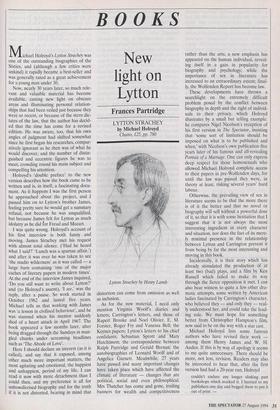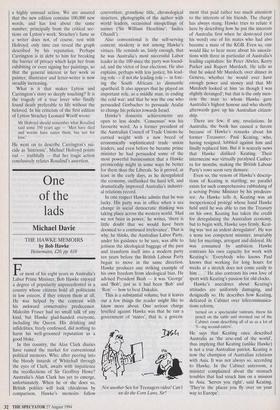BOOKS
New light on Lytton
Frances Partridge
LYTTON STRACHEY by Michael Holroyd Chatto, £25, pp. 780 ichael Holroyd's Lytton Strachey was one of the outstanding biographies of the Sixties, and (although a few critics were unkind) it rapidly became a best-seller and was generally rated as a great achievement for a young man under 30.
Now, nearly 30 years later, so much rele- vant and valuable material has become available, casting new light on obscure areas and illuminating personal relation- ships that had been veiled just because they were so recent, or because of the stern dic- tates of the law, that the author has decid- ed that the time has come for a revised edition. He was aware, too, that his own angles of judgment had shifted somewhat since he first began his researches, compar- atively ignorant as he then was of what he would discover, and the number of distin- guished and eccentric figures he was to meet, crowding round his main subject and compelling his attention.
Holroyd's 'double preface' to the new version describes how the book came to be written and is, in itself, a fascinating docu- ment. As it happens I was the first person he approached about the project, and I passed him on to Lytton's brother James, feeling pretty sure he would get a summary refusal, not because he was unqualified, but because James felt for Lytton as much idolatry as he did for Freud and Mozart.
I was quite wrong. Holroyd's account of his first interview is both funny and moving. James Strachey met his request with almost total silence. (`Had he heard what I said?' Lunch was a spartan affair,') and after it was over he was taken to see `the studio wilderness' as it was called — a large barn containing 'one of the major caches of literary papers in modern times'. At the end of the interview James inquired, `Do you still want to write about Lytton?' and (to Holroyd's assent), 'I see,' was the reply, after a pause. So work started in October 1962 and lasted five years. Michael tells us that working with James was 'a lesson in civilised behaviour', and he was stunned when his mentor suddenly died of a heart attack in April 1967. The book appeared a few months later, after being dragged through the Sundays in man- gled chunks under screaming headlines such as 'The Abode of Love'.
Here I should declare an interest (as it is called), and say that it exposed, among other much more important matters, the most agitating and emotional, the happiest and unhappiest, period of my life. I can read it now with more detachment than I could then, and my preference is all for unbowdlerised biography and for the truth if it is not distorted, bearing in mind that Lytton Strachey by Henry Lamb distortion can come from omission as well as inclusion.
As for the new material, I need only mention Virginia WooIfs diaries and letters; Carrington's letters, and those of Rupert Brooke and Noel Olivier, E. M. Forster, Roger Fry and Vanessa Bell; the Keynes papers; Lytton's letters to his chief confidants, Sebastian Sprott and Mary Hutchinson; the correspondence between Ralph Partridge and Gerald Brenan; the autobiographies of Leonard Woolf and of Angelica Garnett. Meanwhile, 27 years have passed and many important changes have taken place which have affected the climate of literature — changes that are political, social and even philosophical. Mrs Thatcher has come and gone, trailing banners for wealth and competitiveness
rather than the arts; a new emphasis has appeared on the human individual, reveal- ing itself in a gain in popularity for biography and psychology; while the importance of sex in literature has increased to an extraordinary extent; final- ly, the Wolfenden Report has become law.
These developments have thrown a searchlight on the extremely difficult problem posed by the conflict between biography in depth and the right of individ- uals to their privacy, which Holroyd illustrates by a small but telling example: he compares Nigel Nicolson's reception of his first version in The Spectator, insisting that 'some sort of limitation should be imposed on what is to be published and when,' with Nicolson's own publication five years later of his famous and all-revealing Portrait of a Marriage. One can only express deep respect for those homosexuals who allowed Michael Holroyd complete access to their papers in pre-Wolfenden days, for until the law was passed they were, in theory at least, risking several years' hard labour.
Otherwise, the prevailing view of sex in literature seems to be that the more there is of it the better and that no novel or biography will sell without a powerful dose of it, so that it is with some hesitation that I suggest that it is not always the most interesting ingredient in every character and situation, nor does the fact of its mere- ly minimal presence in the relationship between Lytton and Carrington prevent it from being by far the most interesting and moving in this book.
Incidentally, it is their story which has already stimulated the production of at least two (bad) plays, and a film by Ken Russell which failed to make its way through the fierce opposition it met. I can also bear witness to quite a few other dra- matic attempts, some written by American ladies fascinated by Carrington's character, who believed they — and only they — real- ly understood her, and could take the lead- ing role. We must hope for something better from Christopher Hampton's film, now said to be on the way with a star cast.
Michael Holroyd lists some famous authors who have revised their work — among them Henry James and W. H. Auden. If this is by way of apology it seems to me quite unnecessary. There should be more, not less, revision. Readers may also be interested to hear that, after the first version had had a 20-year run, Holroyd
couldn't endure any longer slinking past bookshops which stocked it. I hurried to my publishers one day and begged them to put it out of print —
a highly unusual action. We are assured that the new edition contains 100,000 new words, and has lost about the same number, principally from the critical sec- tions on Lytton's work. Strachey's fame as a writer does not, of course, rest with Holroyd; only time can reveal the graph described by his reputation. Perhaps Carrington is in debt to him for breaking the barrier of privacy which kept her from exhibiting or even signing her paintings, so that the general interest in her work as painter, illustrator and letter-writer is now steadily increasing.
What is it that makes Lytton and Carrington's story so deeply touching? It is the tragedy of a true lover who finally found death preferable to life without the beloved. In his criticism of the first edition of Lytton Strachey Leonard Woolf wrote: Mr Holroyd should remember what Rosalind said some 350 years ago — 'Men have died and worms have eaten them, but not for love.'
He went on to describe Carrington's sui- cide as 'histrionic'. Michael Holroyd points out — truthfully — that her tragic action conclusively refutes Rosalind's assertion.



























































 Previous page
Previous page